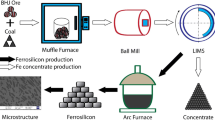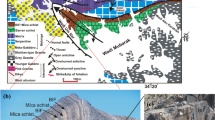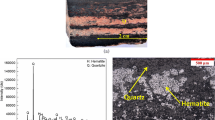Abstract
Banded hematite quartzite (BHQ) and banded hematite jasper (BHJ) ores represent a promising potential iron ore resource in the near future. The hematite and quartz in BHQ and the hematite and jasper in BHJ are closely related and require fine grinding for the liberation of hematite phases. The present study investigates the mineralogical features and comminution properties of BHQ and BHJ ores. In the BHQ ore, it is observed that thick bands of hematite have fine inclusions of silicate minerals, whereas silica bands have few grains of iron-bearing minerals. The hematite and quartz minerals in the iron and silicate bands of the BHJ ore appear to be more intricately associated and complex in nature, presenting difficulties for liberation. Bond work index studies were carried out for the BHQ and BHJ ores with different product fineness in order to evaluate the energy requirements in fine grinding. A higher Bond work index value was found for the BHJ ore (15.4 kWh/ton) than for the BHQ ore (12.4 kWh/ton). A decrease in the product particle size was associated with an increase in the work index value. Single-particle breakage experiments were designed by varying feed particle size and input energy. The specific energy consumption for the BHJ ore was higher than that for the BHQ ore. The comminution parameters showed that the BHJ ore is harder to grind than the BHQ ore, which may be due to the mineral composition and association of hematite phases with the silicates.









Similar content being viewed by others
References
Das B, Mishra BK, Prakash S, Das SK, Reddy PSR, Angadi SI (2010b) Magnetic and flotation studies of banded hematite quartzite (BHQ) ore for the production of pellet grade concentrate. Int J Miner Metall Mater 17(6):675
Rath SS, Sahoo H, Das SK, Das B, Mishra BK (2014) Influence of band thickness of banded hematite quartzite (BHQ) ore in flotation. Int J Miner Process 130:48–55
Das SK, Das B, Sakthivel R, Mishra BK (2010a) Mineralogy, microstructure, and chemical composition of goethites in some iron ore deposits of Orissa, India. Miner Process Extr Metall Rev 31(2):97–110
Srivastava MP, Pan SK, Prasad N, Mishra BK (2001) Characterization and processing of iron ore fines of Kiriburu deposit of India. Int J Miner Process 61:93–107
Rao DS, Vijaya Kumar TV, Subba Rao S, Prabhakar S, Bhaskar Raju G (2009) Mineralogy and geochemistry of a low grade iron ore sample from Bellary-Hospet sector, India and their implications on beneficiation. J Miner Mater Charact Eng 8(2):115–132
Angadi SI, Jeon H-S, Mohanthy A, Prakash S, Das B (2012) Analysis of wet high-intensity magnetic separation of low-grade Indian iron ore using statistical technique. Sep Sci Technol 47:1129–1138
Rath SS, Dhawan N, Rao DS, Das B, Mishra BK (2016) Beneficiation studies of a difficult to treat iron ore using conventional and microwave roasting. Powder Technol 301:1016–1024
Mohanty S, Nayak B, Konar J (2017) Beneficiation of high-alumina bearing iron-ore slime: a case study from eastern India. Miner Process Extr Metall Rev 38(6):403–410
Roy S (2012) Recovery improvement of fine magnetic particles by floc magnetic separation. Miner Process Extr Metall Rev 33(3):170–179
Roy S, Das A (2008) Characterisation and processing of low-grade iron ore slime from the jilling area of India. Miner Process Extr Metall Rev 29(3):213–231
Jena SK, Sahoo H, Rath SS, Rao DS, Das SK, Das B (2015) Characterization and processing of iron ore slimes for recovery of iron values. Miner Process Extr Metall Rev 36(3):174–182
Saeidi N, Noaparast M, Azizi D, Aslani S, Ramadi A (2013) A developed approach based on grinding time to determine ore comminution properties. J Min Environ 4(2):105–112
Narayanan SS, Whiten WJ (1988) Determination of comminution characteristics from single particle breakage tests and its application to ball-mill scale-up. Trans Inst Min Metall C97:115–124
Narayanan SS (1987) Modeling the performance of industrial ball mills using single particle breakage data. Int J Miner Process 20:211–228
Singh V, Dixit P, Venugopal R, Venkatesh KB (2018) Ore pretreatment methods for grinding: journey and prospects. Miner Process Extr Metall Rev. https://doi.org/10.1080/08827508.2018.1479697
Shi FN, Napier-Munn TJ, Asomah IK (2000) Rheological effects in grinding and classification. Miner Process Extr Metall Rev 20(1):123–131
Orumwense OA, Forssberg E (1992) Superfine and ultrafine grinding—a literature survey. Miner Process Extr Metall Rev 11(1–2):107–127
Deniz V, Sutcu N, Umucu Y (2003) The effect of circulating load and test sieve size on the bond work index based on natural amorphous silica. 18th International Mining Congress and Exhibition at Turkey, IMCET 2003, pp 517–522
Wills BA, Napier-Munn TJ (2006) Mineral processing technology, an introduction to the practical aspects of ore treatment and mineral recovery. Elsevier Science & Technology Books
Rodriguez BA, García GG, Alfredo L, Velázquez C, Aguado JMM (2016) Product size distribution function influence on interpolation calculations in the Bond ball mill grindability. Int J Miner Process 157:16–20
Tuzun MA (2001) Wet bond mill test. Miner Eng 14(3):369–373
De Moraes SL, Ribeiro TR (2018) Brazilian iron ore and production of pellets. Miner Process Extr Metall Rev. https://doi.org/10.1080/08827508.2018.1481056
Devasahayam S (2015) Predicting the liberation of sulfide minerals using the breakage distribution function. Miner Process Extr Metall Rev 36(2):136–144
Harris CC, Arbiter N (1985) Grinding mill operation and scale-up: theory and equations. Miner Process Extr Metall Rev 1(3–4):249–263
Sahoo R (2006) Review: an investigation of single particle breakage tests for coal handling system of the Gladstone port. Powder Technol 161:158–167
Tavares TM (1999) Energy absorbed in breakage of single particles in drop weight testing. Miner Eng 12(1):43–50
Sahoo RK, Weedon DM, Roach D (2004) Single-particle breakage tests of Gladstone Port Authority’s coal by a twin pendulum apparatus. Adv Powder Technol 15(2):263–280
Genc O, Erugn L, Benzer H (2004) Single particle impact breakage characterization of materials by drop weight testing. Physicochem Probl Miner Process 38:241–255
Herbst JA, Fuerstenau DW (1980) Scale-up procedure for continuous grinding mill design using population balance models. Int J Miner Process 7:1–31
Saeidi F, Tavares LM, Yahyaei M, Powell M (2016) A phenomenological model of single particle breakage as a multi-stage process. Miner Eng 98:90–100
Casagrande C, Alvarenga T, Pessanha S (2017) Study of iron ore mixtures behavior in the grinding pelletizing process. Miner Process Extr Metall Rev 38(1):30–35
Graça LM, Lagoeiro LE, Lima LMF, Barbosa PF, Machado MM (2015) Effect of the morphological types in grinding of iron-ore products. Miner Process Extr Metall Rev 36(5):324–331
Pal J, Ghorai S, Agarwal S, Nandi B, Chakraborty T, Das G, Prakash S (2015) Effect of Blaine fineness on the quality of hematite iron ore pellets for blast furnace. Miner Process Extr Metall Rev 36(2):83–91
Bond FC (1960) Crushing and grinding calculations. Br Chem Eng 6:378–391, 543–548
Soni RK, Eswaraiah C, Mishra BK (2015) A novel and direct approach for modelling and simulation of impact grinding. Adv Powder Technol 26:1031–1039
Panda L, Das B, Rao DS, Mishra BK (2011) Selective flocculation of banded hematite quartzite (BHQ) ores. Open Miner Process J 4:45–51
Nayak NP, Das A, Pal BK (2012) Feasibility of beneficiation of banded hematite Jasper of eastern India. Int J Eng Res Technol 1(9):1 ISSN: 2278-0181
Mohanty JK, Jena MS, Paul AK (2012) Integrated mineralogical characterization of banded iron ores of Orissa and its implications on beneficiation. J Miner Mater Charact Eng 11:1133–1142
Jankovic A, Dundar H, Mehta R (2010) Relationships between comminution energy and product size for a magnetite ore. J South Afr Inst Min Metall 110:141–146
Magdalinovic N, Trumic M, Trumic G, Magdalinovic S, Trumic M (2012) Determination of the Bond work index on samples of non-standard size. Int J Miner Process 114-117:48–50
Ahmadi R, Shahsavari S (2009) Procedure for determination of ball Bond work index in the commercial operations. Miner Eng 22:104–106
Acknowledgements
The first author, Mr. T. Santosh, would like to acknowledge the Science & Engineering Research Board (SERB), New Delhi, for the Junior Research Fellowship under a grant-in-aid project entitled “Energy efficient advanced comminution processes to treat low grade Indian ores for energy conservation” (Ref. No.: SB/EMEQ-153/2014). The authors would also like to thank the director of the CSIR-Institute of Minerals and Materials Technology, Bhubaneswar, India, for allowing publication of this work.
Author information
Authors and Affiliations
Corresponding author
Ethics declarations
Conflict of Interest
The authors declare that they have no conflict of interest.
Additional information
Publisher’s Note
Springer Nature remains neutral with regard to jurisdictional claims in published maps and institutional affiliations.
Rights and permissions
About this article
Cite this article
Santosh, T., Angadi, S.I., Dash, N. et al. Characterization and Comminution Studies of Low-Grade Indian Iron Ores. Mining, Metallurgy & Exploration 36, 303–312 (2019). https://doi.org/10.1007/s42461-019-0051-0
Received:
Accepted:
Published:
Issue Date:
DOI: https://doi.org/10.1007/s42461-019-0051-0




